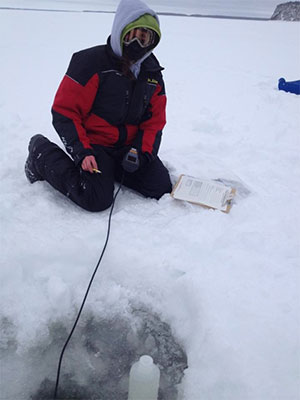
Permafrost loss changes Yukon River chemistry with global implications
December 01, 2016
This is the first time a Yukon River study has been able to use long-term continuous water chemistry data to document hydrological changes over such an enormous geographic area and long time span. The results of the study have global climate change implications because of the cascading effects of such dramatic chemical changes on freshwater, oceanic and high-latitude ecosystems, the carbon cycle and the rural communities that depend on fish and wildlife in Alaska's iconic Yukon River Basin. The study was led by researcher Ryan Toohey of the Department of the Interior's Alaska Climate Science Center and published in Geophysical Research Letters. Permafrost rests below much of the surface of the Yukon River Basin, a silent store of thousands of years of frozen water, minerals, nutrients and contaminants. Above the permafrost is the 'active layer' of soil that freezes and thaws each year. Aquatic ecosystems -- and their plants and animals -- depend on the ebb and flow of water through this active layer and its specific chemical composition of minerals and nutrients. When permafrost thaws, the soil's active layer expands and new pathways open for water to flow through different parts of the soil, bedrock and groundwater. These new pathways ultimately change the chemical composition of both surface water and groundwater. "As the climate gets warmer," said Toohey, "the thawing permafrost not only enables the release of more greenhouse gases to the atmosphere, but our study shows that it also allows much more mineral-laden and nutrient-rich water to be transported to rivers, groundwater and eventually the Arctic Ocean. Changes to the chemistry of the Arctic Ocean could lead to changes in currents and weather patterns worldwide." Another recent study by University of Alberta scientist Suzanne Tank documented similar changes on another major Arctic river, the Mackenzie River in Canada. With two of these rivers showing striking, long-term changes in their water chemistry, Toohey noted that "these trends strongly suggest that permafrost loss is leading to massive changes in hydrology within the arctic and boreal forest that may have consequences for the carbon cycle, fish and wildlife habitat and other ecosystem services." The Domino Effect The Yukon River Basin, which is the size of California, starts in northwestern British Columbia, then flows northwest through Yukon across the interior of Alaska to its delta, where it discharges into the Bering Sea. Eventually, its waters reach the Arctic Ocean; it is one of six major rivers that play an important role in the circulation and chemical makeup of the Arctic Ocean. This study, which analyzed more than 30 years of data, sheds light on how the effects of climate change are already affecting this system. The study specifically found that the Yukon River and one of its major tributaries, the Tanana River, have experienced significant increases in calcium, magnesium and sulfate over the last three decades. As permafrost loss allows for more water to access more soil and bedrock, increased weathering most likely explains these significant increases. In fact, the annual pulse of sulfate in the Yukon River jumped by 60 percent over the past thirty years. This research also suggests that groundwater, enriched with organic carbon and other minerals, is likely contributing to these changes. How long the river stays frozen plays an important role in erosion. The Yukon River ice has been breaking up earlier and earlier, often accompanied by tremendous flooding events that devastate the communities on its banks. At the same time, the river has been freezing up later and later. When the river is unfrozen, its banks and soils are more susceptible to erosion. Phosphorous, often a product of this erosion, has increased by over 200 percent during December. All of these increases impact the aquatic ecosystems of the Yukon River and may ultimately contribute to changes in the Arctic Ocean. Together, said the authors, the research shows that permafrost degradation is already fundamentally transforming the way that high-latitude, Northern Hemisphere ecosystems function.
Note:
Editing by Mary Kauffman, SitNews
Source of News:
Representations of fact and opinions in comments posted are solely those of the individual posters and do not represent the opinions of Sitnews.
|
|||
